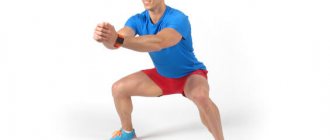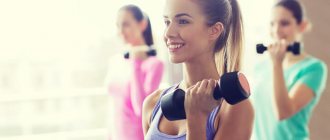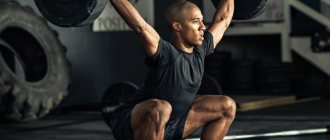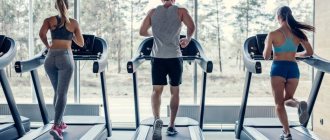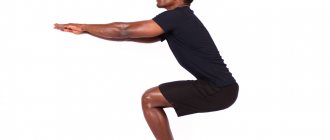What to take with you to training. Rules of behavior in the gym. In what cases is a personal trainer needed? For many novice athletes, the first visit to the gym is a real disaster. On the one hand, everything looks very interesting and educational (a lot of people, interesting equipment, music and drive), but on the other hand, difficulties arise with the training process. It’s not entirely clear how to exercise correctly, what to do in the gym, or whether to hire a trainer or not. In general, there are many questions, and they all require clarification.
Features of muscle physiology
Muscle tissue connected to the skeleton forms the structure of the human body. A person has about 600 different muscles, each of which has its own separate functions and characteristics. They consist of elastic elastic fabric. Their contraction moves individual parts of the body.
When performing various actions, not just one, but groups of muscles work. The more local the movement is, for example an exercise aimed at a specific group, the less they will contract.
Strength is characterized by the maximum weight that a muscle can lift when contracted. Depending on their location on the body, they are divided into groups.
There are muscles:
- Hand.
- Nog.
- Press.
- Necks.
- Breasts.
Each group takes on separate types of loads. Therefore, exercises on simulators are divided into categories of working body parts.
Where to start training in the gym?
- Any workout, especially in the gym, begins with preparing the body for physical activity. Warm up for 10–15 minutes. It is divided into 4 main stages: warming up, spinning, warming up and stretching.
- During the first part, you need to warm up the body with simple intense exercises. Most often this is running, jumping rope, boxing at an easy pace. During these 3-5 minutes, the muscles should warm up and become softer and more elastic.
- Rotations will prepare stagnant joints for active work. Exercises are performed on all parts of the body from top to bottom. This complex will protect against injuries in the joint area during heavy loads.
- At the main stage, a couple of simple exercises are performed for general warm-up and additional warming up of the body . You can jump in place, clapping above your head, squat, and do dynamic bends to each side and to your feet.
- The final part is stretching. It helps increase the elasticity of muscles and ligaments. Be sure to work out the arms, legs, inner thighs and back. This set of exercises prevents accidental sprains and tears of ligaments and joints.
Warm-up cannot be neglected. Thanks to it, training becomes not only safe, but also more effective.
How to work out in the gym without a trainer?
When starting independent training in the gym, you should study in advance the principle of operation of the main simulators and follow the mandatory structure of any training. It includes warm-up, training on exercise machines, and finishing exercises.
- At the main stage, the muscles must be loaded in a certain sequence. The hips and legs are worked on first. After them, they begin to load the pectoral muscles and back, then the shoulders and arms. The work on the simulators is completed by pumping the rectus and oblique abdominal muscles.
- When practicing, be sure to monitor the correct body position and clarity of movements. The load is selected depending on physical fitness. The weight should not be too heavy. It should allow you to perform 2–3 sets of 10–15 repetitions. With each workout, the load on the machines is gradually increased.
- The final stage will allow you to relax muscles that are tense due to training and prevent pain in them the next day. Cardio exercises help with this. About 5 minutes on a treadmill, exercise bike or elliptical at an easy pace will start the process of muscle tissue restoration and relieve severe tension.
Rules of etiquette
Keep in mind that you are not alone in the gym, so you shouldn’t arrogantly take those equipment and climb onto those machines that you need. To avoid problems and behave correctly, follow a few basic recommendations:
- if you are asked to act as a backup, then be sure to do so. If you are not confident in your abilities (for example, you will not be able to lift this or that whole thing on your own if something happens), then it is better to admit it right away;
- if an athlete is training in front of a mirror, then do not stand in front of it and do not block the view;
- You should not use the exercise machine for a long time. On average, it takes about 25-30 seconds to complete one approach, after which you can step away from the exercise for a while and let another person do the exercise. As soon as you have completed your exercise, return the weight of the person doing the exercise at the same time as you;
- You don’t need to wear a lot of scent while hiking. If everyone starts dousing themselves in cologne or perfume, then it will simply be impossible to be in the gym. The only thing that can be done is to treat the armpit area with dry deodorant;
- if the required barbell is occupied, you will have to wait or take a seat and go train on another machine. You can combine classes with another person only if the weights do not differ greatly.
How to exercise correctly to lose weight?
When setting a goal to lose weight, you must first determine the problem areas. Depending on them, simulators are selected. These parts of the body will be loaded and work harder than others.
With large volumes in the lower body: legs, hips and buttocks, these muscle groups should be involved. In this case, it is most effective to exercise on an exercise bike, treadmill, or exercise equipment for strength flexion and extension of the legs. The calf muscles, the front surface of the thigh and buttocks will work the most on them.
For general weight loss, cardio equipment is recommended. They evenly load the entire body and help start the breakdown of fat deposits.
These include:
- Stepper.
- Exercise bike.
- Treadmill.
- Nordic walking.
- Ellipsoid.
They imitate active body movement, such as when running, skiing, cycling or quickly climbing stairs. At the same time, breathing and heart rate increase.
Such exercises should be regular, the number of approaches in each exercise increases gradually as the body gets used to it. Strength exercises for weight loss are performed slowly, without sudden movements or jerks.
Fat-burning complexes with weights begin with a warm-up. During it you need to do 2 - 3 movements with half the planned weight.
Training program in the gym
For women
For beginner girls and women, two visits to the gym per week will be enough to pump up their fitness. At the same time, most fitness exercises will include the work of all muscle groups and additional work on individual zones.
Each lesson begins with a warm-up. To warm up, choose regular treadmill running or jump rope, plus several exercises with your own weight: squats, body turns and bending.
First workout:
| Training | Approaches and number of times |
| Warm-up | |
| Stepper | 2 sets of 5 minutes |
| Squats with a bar | 2 sets of 10 times |
| Oblique lunges with dumbbells | 2 sets of 10 times |
| Chest press | 2 sets 10-15 times |
| Pulldown for the head from the upper block | 1 set 10-15 times |
| Hyperextension | 2 sets of 15 reps |
| Press on the bench | 2 sets of 10 times |
| Ellipsoid | 1 set 5-10 minutes |
| Hitch |
Second workout:
| Training | Approaches and number of times |
| Warm-up | |
| Bench leg press | 1 set 10 minutes of intense riding |
| Exercise bike | 2 sets of 7-10 times |
| Reduction of arms on the simulator | 2 sets of 7–10 reps |
| Horizontal block thrust | 1 set 10 times |
| Raising legs in a block on the horizontal bar | 2 sets of 10 times |
| Pull-ups | 2 sets of 10 times |
| Crunches | 2 sets of 10-15 times |
| Nordic walking | 1 set 10 minutes |
| Hitch |
The number of workouts can increase to three depending on individual physical fitness. The volume of exercises and the number of approaches gradually increases, but should not overload the muscles.
For men
Men put more emphasis on gaining weight, so their workouts will include more strength exercises, and for weight loss they will add cardio equipment, the time on which can be increased to achieve greater results. The optimal number of workouts per week for men is 3 times.
First workout:
| Training | Approaches and number of times |
| Warm-up | |
| Barbell deadlift | 2–3 sets of 10 times |
| Barbell Squat | 3 sets of 7–10 reps |
| Running up on a special track | 1 set 10 minutes |
| Dumbbell up press | 2 sets of 10 times |
| Push ups | 3 sets of 10 times |
| Bench press with weights | 2 sets of 10 times |
| Hyperextension | 3 sets of 10 times |
| Exercise bike | 1 set 10 minutes |
| Hitch |
Second workout:
| Training | Approaches and number of times |
| Warm-up | |
| Lying Leg Press | 3 sets of 10 times |
| Leg extension on the machine | 3 sets of 10 times |
| Arm raises with dumbbells lying down | 3 sets of 10 times |
| Barbell chest press | 2 sets of 7–10 reps |
| Ellipsoid | 1 set 10 minutes |
| Triceps extension on the machine | 3 sets of 10 times |
| Pull-ups | 2 sets of 15 reps |
| Nordic walking | 1 set 10 minutes |
| Hitch |
Third workout:
| Training | Approaches and number of times |
| Warm-up | |
| Stepper | 1 set 10 minutes |
| Squats | 3 sets of 10 times |
| Leg press | 3 sets of 10 times |
| Block pull to the chest | 3 sets of 10 times |
| Head Pull | 3 sets of 10 times |
| Hyperextension with weight | 3 sets of 10 times |
| Crunches on the floor | 2 sets of 15-20 times |
| Running on the track | 1 set 10 minutes |
| Hitch |
The number of approaches during training does not increase more than three. If the load is insufficient, the volume of each approach is added. In the first weeks of training, you should not overload your muscles with strength training. You need to add weight and quantity gradually in an increasing manner.
Train smart
In the training process, it is important to practice competently, taking into account the basic rules and laws of bodybuilding. The following tips are worth highlighting:
- Concentrate solely on bodybuilding. You shouldn’t “spray yourself” on several sports at once. At least for the first few months, classes should take place only in the gym, so that the body gets involved in the basic processes;
- You shouldn’t train every day, because this certainly won’t speed up muscle growth. It would be correct to limit yourself to 2-3 classes during the week. At the same time, the duration of stay in the gym should not be more than 60-70 minutes;
- try not to lean on isolated exercises. As practice shows, the best option for beginners is the “base”. It is important to include exercises such as squats, bench presses, pull-ups, and so on. Work correctly with free weights, which will allow you to pump not only specific muscle groups, but the entire body;
- stretch after your workout. After completing your workout, take at least a few minutes to thoroughly stretch the muscles you prioritized training. High-quality stretching promotes faster recovery of an overloaded muscle group. If this is not done, then the muscles will return to normal within 8-10 hours;
- In addition to the general warm-up in the gym, try to do a small “run” of the muscles before performing the exercise. For example, if you are going to do a bench press with a weight of 40-50 kilograms, then it is better to do the first 10-15 times with an empty bar (20 kilograms). This approach allows you to prepare the muscle group for maximum loads as efficiently as possible.
How to exercise correctly?
On the elliptical trainer
- When walking on such a simulator, the athlete’s legs move along the trajectory of a natural ellipse, from which it gets its name.
- During the movement, the hands clasp the handrails, which move in the opposite direction from each leg.
- The feet can be positioned in the way that is most comfortable.
- The closer they are to the edge, the greater the load will be.
- When exercising on this apparatus, the muscles of the legs, hips, buttocks, arms, abs and pectoral muscles are involved.
- The elliptical machine can be considered a complex exercise machine.
- While moving, you need to monitor the smoothness of your step and do not make sudden movements.
- The center of gravity of the body should always be in one place, distributing the load evenly, and not be transferred from one leg to the other.
- Losing weight requires long enough workouts at a calm pace.
- If you do not use other equipment, the duration of the lesson can reach from 40 minutes to 1 hour.
- To gain muscle mass, calm work is combined with sharp short increases in load.
- To do this, add resistance to the elliptical trainer or sharply increase the pace of movement.
- Popular models of the simulator are Torneo models.
- You can also use an elliptical trainer after a stroke. Only training needs to start with a small amount of time.
On a rowing machine?
- The rowing machine imitates the movements made while rowing a boat.
- Being a cardio exercise machine, it also uses the muscles of the upper body: arms, shoulders, back and abs.
- The technique of working with this projectile is reminiscent of performing a deadlift.
- At the starting point, the athlete’s back is straight, his legs are tense and bent at the knees, his arms are extended and tightly grip the handle.
- To perform the movement, a person pushes off with his legs, straightening them, and pulls the projectile towards himself towards the belt. At the same time, the body leans back slightly.
- To return to the starting position, the tension on the handle is loosened, the body moves forward, and then the legs bend.
During the lesson, you can periodically change your grip, and take short breaks every 10-15 minutes to rest.
Skiing on the trainer?
- The ski trainer is a cardio type and is similar in principle to an ellipsoid. It more accurately simulates the movements made when skiing.
- There are varieties: classical and mountain simulators. But the elliptical view is more popular.
- The legs, standing on the platforms, take steps, and the hands, holding the handles, work in the opposite direction.
- You should exercise on such a machine for about an hour, several times a week.
- In this case, intervals of acceleration and deceleration of the step should alternate.
- The workout ends at a calm pace to restore your heart rate.
On a stepper?
- The stepper (or step simulator) has another name - steps.
- He got it because the projectile simulates a person climbing stairs.
- When performing steps, the gluteal, calf and thigh muscles work. When exercising on this apparatus, it is important to maintain an even posture.
- Movements should be clear, but not sharp, without jumps. When moving, the body leans slightly forward, the knees do not come together.
- If the step machine has handrails, then you just need to hold onto them without leaning or transferring your body weight on them.
- During the workout, the pace alternates. The time of the first lesson starts at 10 minutes and gradually increases with each new session, creating a load that is comfortable for the body.
On street trainers?
Outdoor exercise machines differ from those found in gyms only in that they do not have load adjustment and control of training parameters, such as distance traveled and heart rate.
Most often in courtyards and parks they install:
- Ellipsoids.
- Vertical traction.
- Exercise machines for various types of bench press.
- Hyperextension.
- Abdominal handrails.
- Pull-up bars.
Training on such equipment is no different from training in the gym. Before physical activity, a warm-up is performed with a more intense warm-up than in the gym.
Outdoor weather conditions are often much colder than indoors. When working on such simulators, you need to be more careful than in the gym, since they are rougher and more traumatic.
On weight machines?
Strength trainers are divided into types:
- Using the athlete’s own weight – parallel bars, hyperextension, horizontal bar, abdominal bench.
- Using artificial weight - various stations with built-in weight.
- Using free weights - an athletic bench and various rows.
Working with any of these simulators requires a thorough warm-up. All movements must be performed correctly and clearly, but at the same time smoothly.
In strength training, sudden movements and jerks are not allowed. Additional weight or force increases the risk of injury and damage. Therefore, it is important to follow safety precautions.
Additional weight is selected based on the athlete’s physical fitness. It shouldn't be too big. Ideally, the additional load should allow you to perform 2-3 sets of 10 times without overstraining the body. In the process of further training, the load gradually increases as you get used to it.
On the machines in the gym?
Exercise machines differ in their purpose for specific muscle groups or actions. They come in various models and manufacturers. Some of the most popular brands are “House fit” and “Torneo”. They are purchased both for home use and for specialized gyms.
When exercising in gyms equipped with simulators, you must follow certain rules:
- Each workout should have a warm-up and cool-down to prevent accidental injuries.
- When working with training equipment, each athlete is obliged to follow safety precautions and perform the exercise correctly.
- Training should be regular and comprehensive. Each time the emphasis is placed on one of the muscle groups. But at the same time, the exercises should not be monotonous; almost the entire body is involved.
- Classes are not attended on a full stomach. You can train a couple of hours after eating.
- All recommendations and adjustments made by the trainer for performing the complexes must be followed.
These rules help to avoid injuries and damage to work equipment. And most importantly, a positive training result will be achieved: losing weight and gaining the right muscle mass.
On a Leg Press machine?
- Leg press is translated as leg press.
- This simulator consists of a bench on which the athlete lies and a footrest.
- The feet are placed straight at a short distance from each other, the knees are bent at an angle of 45 degrees.
- Movements are carried out by bending and straightening the legs at the knee joint under the weight of the platform.
- When working on such a setup, all leg muscles are used: calf, quadriceps and gluteus maximus.
- While working, it is important to keep your back straight and not arch your lumbar region. Movements should be smooth, without sudden jerks or throwing the platform.
On hyperextension?
- This machine is a bench with supports for the feet, hips and bolsters to support the legs.
- It performs the movement of flexion and extension of the back at the waist.
- The athlete rests his feet on the machine and lowers his body down, bending over the machine to an angle of 60 degrees.
- After this, the body rises to its original position.
- This simulator uses the muscles of the back corset, abs, buttocks and back of the thigh.
- When performing, the arms are kept crossed on the chest or locked behind the head and do not help in the execution.
- In the second variant of the placement of the arms, the elbows should not follow the direction of movement, but should be kept straight.
- When going down, inhale, and when going up, exhale.
- All movements are smooth, without sudden swings.
- Do not lower the body too low or move too far at the top.
- The back is straight when moving, does not bend in the lumbar region.
On a trainer bike?
- This simulator is as similar as possible to regular cycling.
- While moving on it, your feet should be positioned straight on the pedals, resting on the entire surface.
- The posture remains straight, with a slight tilt of the body forward.
- A bicycle is considered a cardio exercise machine.
- It involves the calf muscle and quadriceps.
- When working with the machine, it is important to monitor your pulse and even breathing.
- Classes should be long, and the power should be adjusted to the desired load.
On the ab bench?
- This exercise machine is a bench located at an angle and a support for fixing the legs.
- The athlete is positioned upside down, legs bent and feet placed behind the support.
- The lower back is pressed tightly to the surface.
- Hands are clasped behind the head. Elbows are separated and do not reach forward.
- While lifting, the neck continues the spine; the chin should not reach towards the chest.
- When performing, the body rises to its maximum point. First, the shoulders come off the bench, then the back.
- The lift is made to a right angle with the legs. The body is fixed in this position for a couple of seconds and smoothly lowers.
- You cannot jerk off the bench and throw your body while lowering. Exhale as you rise, and inhale as you lower your body.
- Breathing should be constant and measured. Bending is accomplished precisely by the abdominal muscles; weight should not be placed on the legs.
- In this case, the exercise will be ineffective.
In addition to simple curls, you can perform other exercises. Crunching is another variation of the abdominal exercise. It does not involve the lower back and pelvis. Only the shoulder blades come off the bench. Movements are performed frequently, at a fast pace, but without jerking.
For a bicycle, the athlete positions himself in reverse, grabbing the stops with his hands. The legs are bent at the knees to a right angle and raised perpendicular to the body. In this position, pedal for 30 seconds to 1 minute. It is important not to put the load on your arms, but to perform movements using the abdominal muscles.
The abdominal muscles work primarily on the bench. The back and hamstrings are also involved. For the effectiveness of the lesson, 3 approaches are performed, each of them contains 10-15 lifts and lowerings.
Using a Nordic walking machine?
- This simulator is similar to a stepper or ellipsoid.
- The legs are placed on platforms, the hands hold on to levers that move in the opposite direction to the legs.
- Its difference is that the legs do not move in a vertical plane, but in a more horizontal, straight trajectory.
- The apparatus maximally imitates the movements performed during Nordic walking classes.
- It falls into the cardio category and uses the maximum number of muscles.
- But more attention is paid to the work of the legs and shoulders.
- Nordic walking at a moderate pace is great for completing your workout in the gym, although it can also be a core exercise.
- In this case, it should be more intense and longer.
On a Smith machine?
- The Smith machine is suitable for loading the buttocks, legs during squats and the chest, arms and shoulders during various presses. Great for girls.
- The Smith machine allows beginners to perform a number of exercises for targeted muscle training.
- Place your supporting leg on a bench or other elevated platform. These are actually Bulgarian lunges in Smith.
- With this exercise, the muscles of the working leg are maximally loaded, since the supporting leg is not involved in the movement.
- The gluteal muscle of the working leg is also stretched more strongly, which improves its development.
- Stand directly under the machine. Feet shoulder width apart. Conveniently place the barbell on the trapezius muscles of the back - just below the neck.
- Bend your back slightly at the lower back and look forward. Step your working leg forward a little so that when you lunge, when your thigh is parallel to the floor, the angle at the knee joint is 90°.
- As you inhale, move your supporting leg back and do a squat. Select the step width depending on your goals.
- A wide step focuses on the buttocks, a normal step focuses on the quadriceps.
- The distance between the feet should be such that the supporting leg bends at an angle of at least 90° when squatting.
- The body weight always falls on the heel of the working leg. As you exhale, rise up and put your supporting leg back. Do not straighten your knees completely.
- This will not only protect your knee joints, but also give the muscles additional static load.
The most common mistakes in the gym
All beginners make mistakes during training. Some of them are not very critical, others are more significant and affect the effectiveness of the training.
Among them are the most common:
- Unchanging training program. If you do the same exercises day after day, your muscles will quickly get used to it and stop developing. You need to alternate loads on different muscle groups and change the program at least once a month.
- Lack of rest. Daily training will not give greater results. Muscle tissue needs periodic breaks to grow and repair. It is enough to visit the gym 3 times a week.
- Water during classes. You should drink after completing exercises. If you are very thirsty, just wet your lips, rinse your mouth, or take 1-2 small sips.
- Wrong shoes. Often beginners go to the gym in flip-flops or sandals. These shoes are not suitable for sports and do not support the foot correctly. It can lead to dislocations and sprains.
- Incorrect technique. This is the most common mistake. Violations of the technique do not fully or not load the necessary muscles at all. Because of this, the exercise becomes ineffective. In addition, it can lead to injury.
- Maximum loads. If you overload the body, it will respond with severe muscle pain and stiffness of movement. Loads should be moderate but regular.
Start of training
Let's say you are well equipped and ready to practice 100%. How to do this correctly? Follow a few simple tips here:
- don't listen to anyone. As a beginner, you will be given a lot of “useful” advice on what to eat or drink, how to train, how many approaches to do, and so on. Don't trust all recommendations - filter the information. You can only trust a professional trainer who is based on extensive experience;
- don't rush anywhere. The problem with many newcomers to the gym is that they want to experience everything for themselves, to “put” themselves through all the equipment on the very first day. This could end very badly. It is important to start with a few exercises, work with light weights and as slowly as possible to allow the muscles to feel the new load. Otherwise, at the next training session you will no longer be able to exercise;
- don't start without warming up. At the initial stage, warming up is the key to successful training. It is important to properly stretch the major muscle groups to prevent serious injury. In this case, it is not enough to wave your hand several times - do a full set of warm-up exercises. You need to warm up everything - from the neck to the feet;
- work only according to the program. You shouldn’t practice according to the principle “I’ll do what I like.” With this approach, even years spent in the gym may not produce results. A high-quality program will allow you to systematically achieve results and work out all muscle groups;
- postpone the workout if your muscles are very sore from the last session. Often, excessive stress applied to obvious pain can lead to injury. It is better to limit yourself to a regular warm-up and simple aerobic exercises, for example, running or riding an exercise bike;
- don't expect quick results. Many people believe that it is enough to exercise for 1-2 months to achieve the expected relief. But that's not true. The first results come only after 3-4 months of training. And this is true provided that everything is done correctly. In this case, you should not rely on scales. The best identifier for results is photographs. Take a photo of your body before you start working out in the gym and about 3-4 months later. If the result is visible, then you are doing everything right.

Proper nutrition
When training in the gym, it is important to follow the basics of proper nutrition. Food helps maintain a healthy state, proper fat burning and muscle growth. It is important for athletes to eat foods rich in protein. It includes: eggs, cottage cheese, chicken meat. It promotes muscle development.
Don't forget about fast carbohydrates, greens and foods containing calcium. It will strengthen the musculoskeletal system. It is also especially important to drink a lot of water, since during training the body loses it in large quantities.
Working out both at home and in the gym, together with the right diet, will lead to a beautiful and healthy shape. But achieving this result is not possible without following the correct technique. Therefore, before visiting the gym on your own, it is important to familiarize yourself with the theory, and during training, follow all the recommendations and instructions of the trainer.

Alexandrova Anastasia
Nutrition and healthy lifestyle specialist and author of myfitnesblog.com. For many years, she has successfully helped women and men lose weight and maintain a beautiful figure.
General recommendations
The first thing you need to start with is preparation for the training process. You need to properly pack your gym bag to ensure you have everything you need at the gym for a complete workout. You will need:
- comfortable clothes. Be sure to wear quality shoes on your feet. The main requirements are lightness and maximum comfort for the foot. The best option is sneakers. As for the rest, you don’t have to worry too much about it - wear sweatpants and a T-shirt;
- water. Be sure to take 0.5-1 liter of clean water with you, which is simply necessary to cover losses during exercise in the gym. Taking a small sip of water after each approach is only a plus;
- gloves for training. The palms tend to sweat, which can lead to the load slipping during the exercise. To avoid problems and protect your hands from injury, it is better to wear special “fingerless” gloves. It is much more convenient to practice in them, and your hands are well fixed on the implements;
- two towels. Why two? You will need the first one for wiping your face, and the second one for placing it on the bench for studying.



